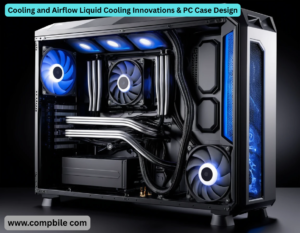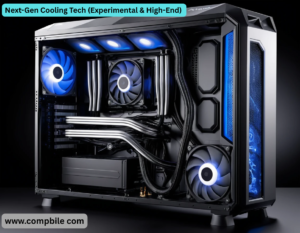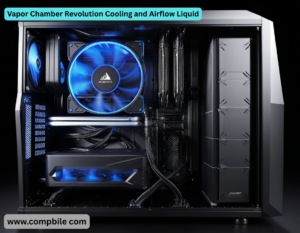Cooling and Airflow Liquid Cooling Innovations & PC Case Design The PC hardware industry is constantly evolving, with liquid cooling innovations and PC case design playing pivotal roles in thermal management and airflow optimization. Here’s a breakdown of the latest trends and advancements:
1. Liquid Cooling Innovations
- Liquid cooling has moved beyond traditional AIO (All-in-One) coolers and custom loops, with new technologies enhancing efficiency and aesthetics:
A. Advanced Pump & Cold plate Designs
- High-Efficiency Microchannel Cold plates – Improved heat transfer with finer channels for better CPU/GPU contact.
- Magnetic Levitation (Mag Lev) Pumps – Quieter operation, longer lifespan (e.g., Corsair’s Mag Lev fans in AIOs).
- Dual-Chamber Pumps – Reduces vibration and improves coolant flow (seen in NZXT Kraken and Arctic Liquid Freezer III).
B. Phase-Change & Refrigeration Cooling
- Hybrid Phase-Change Coolers – Combining liquid cooling with vapor-chamber tech for extreme heat dissipation (e.g., Cooler Master Master Liquid ATMOS).
- Peltier (TEC) Cooling – Active thermoelectric cooling for sub-ambient temps (limited by condensation risks but gaining R&D traction).
C. GPU-Specific Liquid Cooling
- Direct-Die Cooling for GPUs – Removing the IHS (Integrated Heat Spreader) for better thermal transfer (used in MODDED builds and some pre-built systems).
- AIOs for GPUs – Brands like MSI, ASUS, and EVGA now offer hybrid GPU models with integrated liquid cooling.
D. Smart & RGB-Integrated Cooling
- LCD Screen AIOs – Real-time temp displays and customizable graphics (e.g., NZXT Kraken Z-series, Corsair i CUE H150i Elite LCD).
- Software-Controlled Flow & RGB – Dynamic adjustments via apps like i CUE, CAM, or AIDA64.
A. Optimized Airflow-Focused Cases
- Mesh Front Panels – Replacing solid panels for better intake (e.g., Fractal Design Torrent, LIAN Li Lan cool 216).
- Dual-Chamber Layouts – Isolating PSU and drives for cleaner airflow (e.g., LIAN Li O11 Dynamic, HYTE Y60).
- Vertical GPU Mounting – Improves airflow but may require PCIE risers.
B. Liquid Cooling-Specific Features
- Built-in Distro Plates – Cases like the LIAN Li O11D Evo XL and Phan TEKS EVOLVE X include reservoirs for custom loops.
- Radiator Support – Many cases now support 360mm, 420mm, or even dual radiators (e.g., Corsair 7000D, Thermaltake Core P8).
- Modular Mounting Points – Adjustable brackets for flexible radiator placement.
D. Small Form Factor (SFF) Liquid Cooling
- Mini-ITX Cases with Radiator Support – NZXT H1 V2, Form D T1, SSUPD Mesh LICIOUS allow for 240mm AIOs in tiny builds.
- External Radiator Mounts – Some SFF cases support external cooling solutions (e.g., Mo-Ra3 360).
3. Future Trends
- Two-Phase Immersion Cooling – Experimental (used in data centers) but may trickle down to extreme PC builds.
- Graphene & Nanofluid Coolants – Research into better thermal conductivity liquids.
- AI-Driven Cooling – Smart systems that adjust fan/pump speeds dynamically based on workload.
Next-Gen Cooling Tech (Experimental & High-End)
A. Two-Phase Immersion Cooling
- How it works: Submerges PC components in a non-conductive dielectric fluid (like 3M NOVEC) that boils at low temps, carrying heat away as vapor.
- Current use: Mostly data centers (e.g., Ice o tope, Liquid Stack), but DIY kits like Jing hua Fluid’s mineral oil baths exist for extreme enthusiasts.
- Pros: Near-silent, no dust, extreme cooling.
- Cons: Expensive, messy maintenance, limited component compatibility.
B. Nanofluid Coolants
- What’s new: Suspending nanoparticles (graphene, alumina) in coolant for ~20% better thermal conductivity than standard fluids.
- Brands testing it: EKWB, Mayhems (research phase, not mainstream yet).
- Challenge: Particles can clog micro channels over time.
C. Electrohydrodynamic (EHD) Cooling
- Concept: Uses electric fields to ionize air/liquid, creating silent, fan less airflow.
- Status: Lab-stage (MIT experiments), but could revolutionize SFF cooling.
2. Liquid Cooling for Extreme Overclocking
- A. Chiller Systems (Sub-Ambient Cooling)
- How it works: Cools liquid below room temp using a refrigeration unit (like Cooler Master Master Liquid ATMOS).
- Risk: Condensation → requires heating pads & insulation (e.g., Frost King foam tape).
- Use case: Competitive overclocking (LN2 alternative).
- B. Peltier (TEC) + Liquid Hybrids
- Example: EKWB TEC Block (thermoelectric cooling combined with water blocks).
- Drawback: High power draw (needs separate PSU).
- C. Dry Ice & LN2 Pots for GPUs
- MODDED water blocks with copper pots for extreme cooling (see der8auer’s experiments).
PC Case Design: Pushing Airflow & Aesthetics Further
1. The Rise of “Negative Pressure” Cases
- Concept: More exhaust than intake fans → creates vacuum effect, pulling air through unfiltered gaps.
- Pros: Can improve GPU temps in some layouts.
- Cons: Dust buildup (needs frequent cleaning).
3.Vertical Airflow Dominance
- New trend: Cases designed for bottom-to-top airflow (heat rises naturally).
- Example: Silverstone Alta F2 (PSU on top, GPU fans breathe from below).
- Benefit: Great for RTX 4090/AMD 7900 XTX cards with axial fans.
4.SFF (Small Form Factor) Innovations
- Sandwich Layouts: GPU + CPU on opposite sides (e.g., Form D T1).
- External Radiators: Mo-Ra3 360 (massive rad outside the case).
- 3D-Printed Modular Kits: Custom SFF cases with liquid cooling support (check r/SAFFPC).
Pro Tips for Optimizing Cooling
- Airflow Direction Matters:
- Front-to-back (classic) vs. bottom-to-top (better for modern GPUs).
- Avoid mixing directions (e.g., don’t have side fans fighting front intake).
- Liquid Cooling Maintenance:
- Custom loops: Flush every 6-12 months (use Mayhems Blitz Kit).
- AIOs: Lifespan ~5 years (pump failure is common).
- Dust Management:
- Positive pressure (more intake than exhaust) reduces dust.
- Magnetic filters (e.g., Dem CIFLEX) for easy cleaning.
- Under VOLTING+ Cooling:
- -50mV on CPU/GPU can drop temps 5-10°C with no performance loss.
1. Vapor Chamber Revolution
- What’s new: Once exclusive to high-end GPUs (like the RTX 4090), vapor chambers are now appearing in CPU coolers (e.g., Cooler Master V8 3DVC).
- How it works: A sealed chamber with a coolant that evaporates/condenses, spreading heat 5x faster than copper heat pipes.
- Future: Expect entire motherboard vapor chambers for ultra-thin PCs.
2. Peltier (TEC) Cooling: The Comeback
- Why it died: Condensation killed PCs in the 2000s.
- Why it’s back: Better PID controllers (like EKWB’s TEC Quantum) now prevent dew point breaches.
- Best use case: Sub-ambient cooling for Ryzen 9/Intel i9 without LN2.
3. Phase-Change Cooling (Like Air Conditioning for PCs)
- How it works: Compressor-based refrigerant cooling (similar to a fridge).
- Examples:
- ASETEK VAPO chill (2000s relic) – Hit -40°C, but bulky.
- Cooler Master Master Liquid ATMOS – Modern take, quieter.
- Downside: Needs 500W+, expensive (~$1000).
4. Liquid Nitrogen (LN2) & Dry Ice for Enthusiasts
- LN2 Pots: Copper blocks for CPUs/GPUs (see der8auer’s record-breaking OC).
- Dry Ice Tricks:
- “Dice” cooling (-78°C) with acetone slurry for 24/7 stability.
- Insulation: Neoprene foam + vase line to prevent condensation shorts.
2. The “Stack Effect” & Chimney Cooling
- Best setup:
- Bottom: 2-3x 140mm intake.
- Top: 360mm radiator (exhaust).
- Result: 5-8°C lower GPU temps vs. traditional front-to-back.
3. Dust Science: How to Actually Beat It
- Positive pressure (more intake than exhaust) + fine mesh filters = 90% less dust.
- Pro tip: Place PC 6+ inches off the floor (dust settles low).
- Anti-static wipe trick: Use used dryer sheets as cheap dust traps near intakes.
Get article on pdf file….Click now
………..Cooling and Airflow Liquid Cooling Innovations & PC Case Design………




